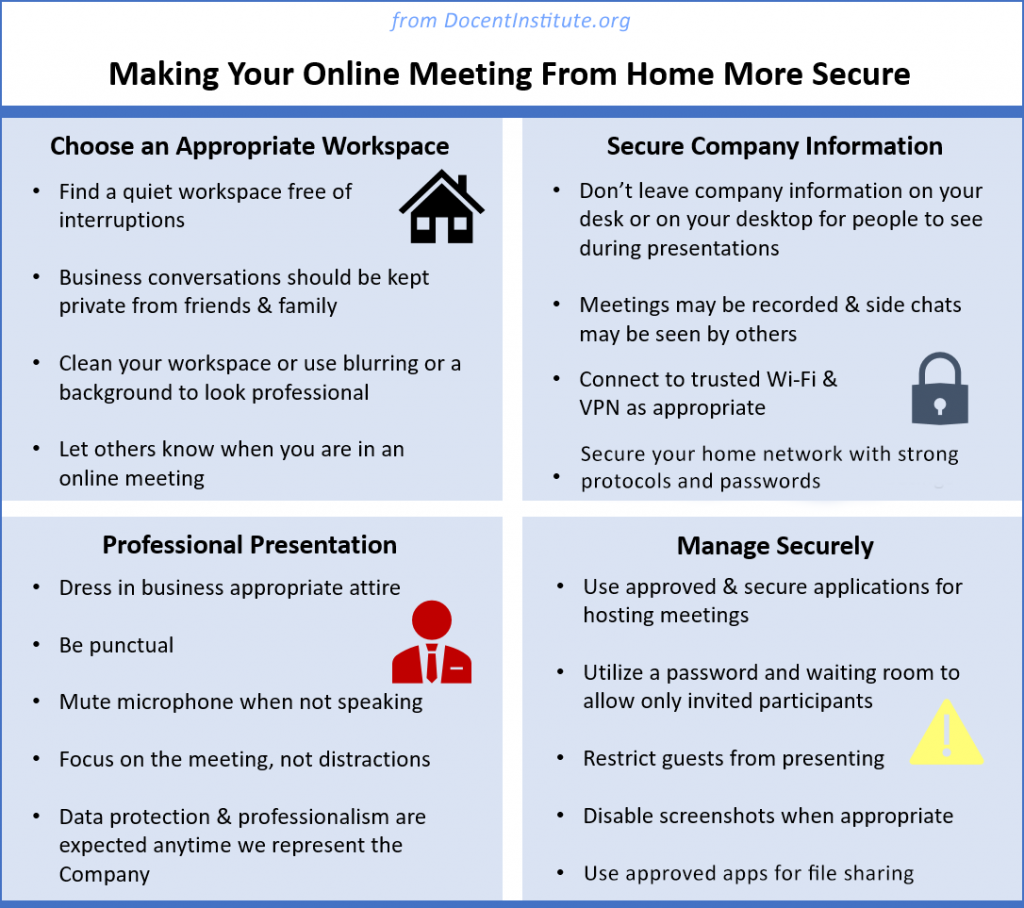
Attending and hosting online meetings from outside the office
Now that people are working from home, we are all participating in a lot more online meetings. Whether you are experienced, or new to working away from the office, there are some tips to follow for productive and professional online meetings. Video conferencing tools like Microsoft Teams, Webex and others can be a great way to keep in touch with your team, your colleagues and business partners. It is nice to see co-workers that you are used to seeing in the office, when you are required to work from home. At the same time, it is important to treat business meetings like you would from the office. This means following basic workplace policies for appropriate dress, security, privacy and etiquette.
Choosing an appropriate workspace
Start by finding a good place to work or join your online meeting. It should be a private space that is quiet, likely to be free of interruptions, and where you can have private business conversations. We’ve all been in online meetings it seems, where colleagues are interrupted by kids or pets. While this can be fun for a social gathering, it is best to find a workspace where this is less likely to happen. Let your family know when you have a meeting to avoid those interruptions.
For those times we are not at home, we should be careful when joining calls and online meetings from public spaces. We want to avoid having others overhear our work conversations or shoulder surf company information from our screens. Consider finding a private and quiet space and use a headset and privacy screen to keep your meeting private.
Make sure that your local wi-fi has strong security and passwords. Many people forget to change the default password on their home router. In order to carry out company business and keep your software up to date, use your company VPN connection. This will also help to add another layer of security by encrypting all of your work traffic.
Secure company information appropriately
Company information can also be exposed when you leave your computer without locking it, or leave out documents and notebooks, or join a video conference with company information visible on a whiteboard or on the desktop of your computer if you are presenting. Always consider what others may see or hear and follow company policies for the security of your laptop.
Some meetings are being recorded, be aware of this and if you have concerns, voice them early on. Because of privacy regulations, some meetings cannot be recorded if someone makes a request for privacy. If you are the host, you should make people aware if you plan to record the meeting. Similarly, many of us have Google, Alexa or other devices in our homes with microphones and cameras. These should be unplugged or removed from your workspace so there is no possibility that sensitive work conversations are recorded or shared with third-parties.
Chat conversations may be visible to the host so it is important to keep all chat conversations professional and avoid sharing sensitive company information.
Realize that others may take screen shots during your presentation. If you do not want that, announce it up front. Likewise, for a sensitive presentation, ask and respect the presenter’s decision. If you want a copy of the presentation materials, ask the presenter.
When working from home, your personal life and work life are bound to overlap. It goes without saying that company discussions and even that screenshot of your team, don’t belong on the Internet. When you post personal photos to social media, make sure that company information isn’t in the picture.
Your company computer is intended for company business and not shared. It may be tempting to use your company laptop so your child can do their homework but find another alternative.
Present yourself as a professional
Even though you are not in the office and may have a very different dress code at home, when you are online, especially in video conferences, it is important that your workspace and attire reflect your role as a professional. Wear what is business appropriate, as you would attending an online or in-person meeting from the office. Remember that microphones and cameras may catch you off-guard, so always be aware and mute your microphone when you aren’t speaking.
In order to present yourself best online, you should test your microphone, camera and Internet connection in advance. Set your computer up in a place with good lighting. Know what you are presenting to others before you go live.
It seems that everyone expects you to enable video for meetings these days, but it can also lead to video fatigue. We can’t always be presentable for that early morning meeting. Unless it is expected that you use video, consider disabling video when it isn’t needed. This may also help if there are bandwidth issues, as not everyone may have a fast connection at home.
Online etiquette
Behavior for online meetings should be no different than if you were participating in an online meeting at the office, however it can be easier to be distracted, interrupted or let your guard down when attending a meeting from home.
Whether you are the host or an attendee, it is important to be punctual and follow an agenda. You want to respect the time and contribution of the other attendees. If the timing of the meeting is poor, or if you will be distracted, consider letting the organizer know or reschedule if you are the host.
If you have background noise, remember to mute your audio (and video) as necessary and remember to unmute to speak. Be courteous and don’t speak over others. You may want to ask attendees to raise their hand or type in chat if you are the host, especially for larger meetings.
Give others your attention and don’t be distracted with other work on your computer. If you are distracted, it is much more obvious when you are on video. If you do need to quickly respond to something or answer a phone, mute your microphone and consider muting your video and returning quickly to the meeting or let the host know you need to drop off for something urgent. Be mindful of the other attendees and their contributions.
Meeting management
Keep your meetings focused and stick to an agenda. There is a time for socializing, however if you only need a quick 15 minutes to discuss things, there is no need to stretch it out until the end of the scheduled meeting time. If there is no need for a meeting, cancel it in advance.
Company approved conferencing tools should always be used for hosting a meeting. While other conferencing software may not be approved for download or use for hosting Company online meetings, some vendors and business partner hosted meetings and webinars may utilize them and if you attend, you should join in your browser if possible.
Best practices for hosting a secure online meeting:
- Ensure that the traffic is encrypted end to end. This is the default with Microsoft products. Some other vendors have had issues with security.
- Utilize the waiting room functionality to ensure only invited attendees are participating. For example, when setting up a Skype meeting, you can choose to make everyone sit in a waiting room, or just put guests in the waiting room.
- Set your default audio settings to mute participants when they initially join.
- When you have guests, you have the option to restrict them from presenting. This will prevent what has come to be known as ‘Zoom-bombing’, where a stranger finds a link to your meeting and then presents inappropriate material.
- If you do not want people to take screenshots, announce that at the start.
- Announce it if you plan to record the meeting.
Use your common sense
The bottom line is to use your common sense! Whether you are at home, in a public location or at the office, you can make the experience of online meetings a professional one by preparing and planning for the unexpected. Data protection and professionalism continues with us whenever we are representing the Company.
